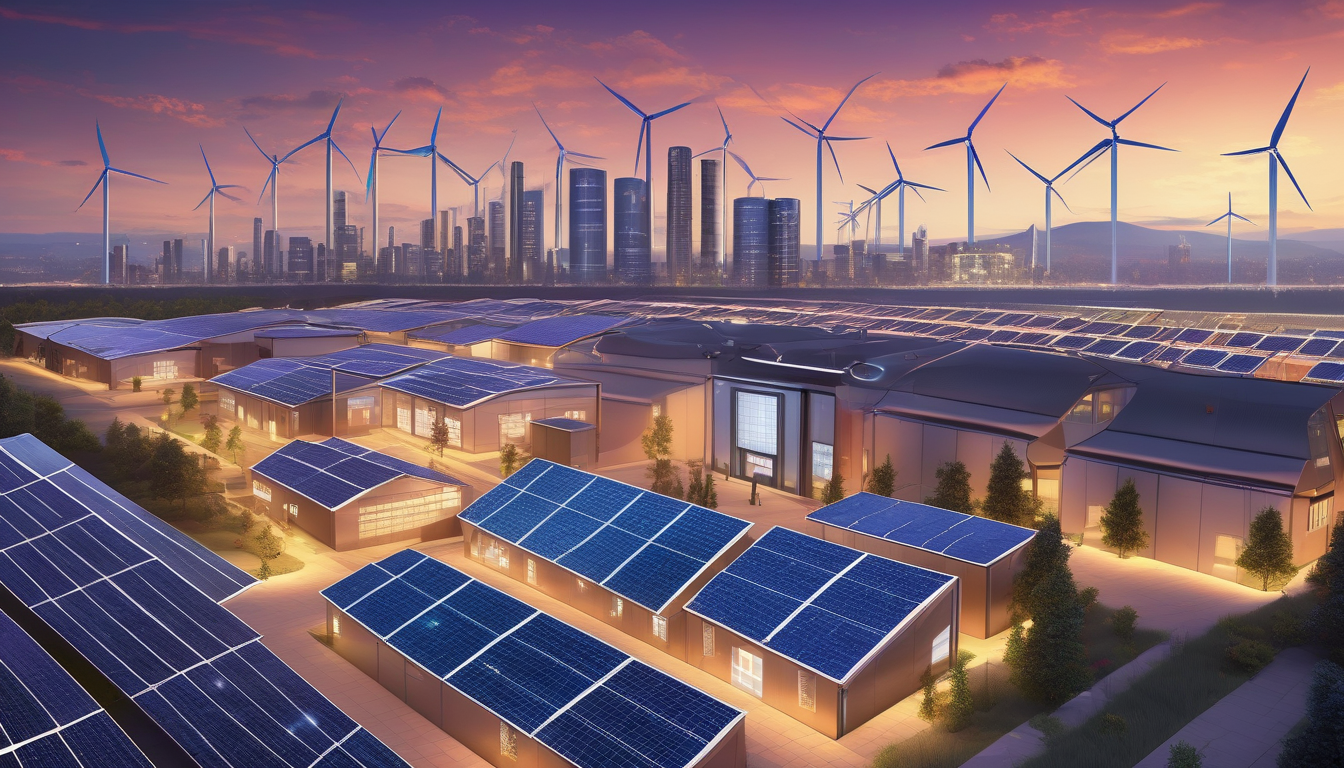In today’s fast-paced world, the energy sector is undergoing a remarkable transformation thanks to the power of artificial intelligence (AI). Imagine a world where energy is not only produced efficiently but also consumed wisely, reducing waste and environmental impact. This is not just a dream; it’s becoming a reality as AI technologies are integrated into energy management systems.
AI’s role in optimizing energy production and consumption is akin to having a smart assistant who knows your preferences and adjusts accordingly. By analyzing vast amounts of data in real-time, AI helps energy providers make informed decisions that enhance operational efficiency. This means lower costs for consumers and a more sustainable energy landscape. Who wouldn’t want that?
One of the key benefits of AI in the energy sector is its ability to perform predictive analytics. Just like a weather forecast helps you plan your day, AI forecasts energy demand patterns. This allows energy companies to align their production with actual consumption, minimizing waste. Picture a scenario where energy is available precisely when you need it, without the excess that leads to higher costs and environmental strain.
Moreover, the integration of AI with smart grid technology is revolutionizing energy distribution. Smart grids equipped with AI can manage renewable energy sources more effectively, ensuring that energy flows where it’s needed most. This means a more reliable energy supply and a stronger infrastructure capable of withstanding fluctuations in demand.
As we look to the future, the potential of AI in energy is boundless. With ongoing advancements, we can expect to see even smarter energy systems that not only enhance efficiency but also contribute to a greener planet. So, as we embrace these innovations, let’s envision a future where energy is not just consumed, but consumed wisely, leading to a sustainable and prosperous world.

Understanding AI’s Role in Energy Management
Artificial Intelligence (AI) is not just a buzzword; it’s a game changer in the energy sector. Imagine having a digital assistant that constantly analyzes data, predicts trends, and makes real-time decisions to optimize energy management. That’s precisely what AI does! By harnessing the power of AI, energy providers and consumers can experience a significant boost in operational efficiency and cost savings.
At the heart of AI’s role in energy management is its ability to process vast amounts of data swiftly. Traditional energy management systems often struggle with data overload, leading to inefficiencies and wasted resources. In contrast, AI algorithms can sift through this data, identify patterns, and provide actionable insights. This means that energy providers can make informed decisions about production levels, maintenance schedules, and resource allocation, all while reducing costs.
Furthermore, AI enhances energy management by enabling predictive analytics. This technology allows companies to forecast energy demand accurately. For instance, by analyzing historical consumption data, AI can predict peak usage times and adjust production accordingly. This proactive approach not only minimizes waste but also ensures a stable energy supply, which is crucial for both consumers and businesses.
One fascinating aspect of AI in energy management is its integration with smart grids. Smart grids are like the nervous system of energy distribution, and when combined with AI, they become incredibly efficient. AI can optimize grid operations, manage renewable energy sources, and even help in real-time load balancing. This integration leads to a more resilient energy infrastructure, capable of adapting to fluctuations in demand and supply.
In summary, AI’s role in energy management is transformative. It’s about more than just efficiency; it’s about creating a sustainable future. As we continue to embrace AI technologies, we can expect smarter energy systems that not only meet our current needs but also pave the way for a greener planet.

Predictive Analytics for Energy Demand
In today’s fast-paced world, predictive analytics has emerged as a game-changer in the energy sector. By harnessing the power of data, AI can forecast energy demand patterns with remarkable accuracy. Imagine being able to predict how much energy your city will need on a hot summer day or during a chilly winter night. This capability allows energy companies to align their production with actual consumption, reducing waste and ensuring a stable energy supply.
But how does this work? At its core, predictive analytics utilizes historical data and advanced algorithms to identify trends and patterns. For instance, by analyzing past energy usage, weather conditions, and even social events, AI can generate forecasts that help energy providers make informed decisions. This not only enhances operational efficiency but also contributes to sustainability by minimizing excess energy production.
Consider the following benefits of predictive analytics in energy demand:
- Cost Reduction: By accurately predicting demand, companies can avoid overproduction, which often leads to wasted resources and higher operational costs.
- Enhanced Reliability: Predictive analytics helps in maintaining a consistent energy supply, reducing the likelihood of outages during peak demand.
- Environmental Impact: By optimizing production schedules, energy providers can lower their carbon footprint and contribute to a greener planet.
Moreover, the integration of predictive analytics with smart grid technology further amplifies its benefits. Smart grids can automatically adjust to real-time data, ensuring that energy distribution is not only efficient but also responsive to immediate needs. This dynamic interaction between predictive analytics and smart grids paves the way for a more resilient energy infrastructure.
As we look to the future, the role of predictive analytics in energy demand will only grow. With ongoing advancements in AI and data analysis, we can expect even more sophisticated models that will enhance our ability to manage energy resources effectively and sustainably.

Smart Grids and AI Integration
Imagine a world where electricity flows as smoothly as water from a tap. That’s the promise of smart grids, and when paired with artificial intelligence, the results are nothing short of revolutionary. Smart grids leverage advanced technology to enhance the distribution and management of electricity, making them more efficient and resilient. But what truly sets them apart is their ability to integrate AI, which transforms raw data into actionable insights.
AI integration in smart grids allows for real-time monitoring and management of energy consumption. This means energy providers can instantly see where power is being used, identify inefficiencies, and make quick adjustments. For instance, when demand spikes during a hot summer afternoon, AI can analyze usage patterns and predict where additional energy is needed, ensuring that every household stays cool without overloading the system.
Moreover, AI helps in managing renewable energy sources more effectively. As wind and solar energy can be unpredictable, AI algorithms can forecast energy production based on weather conditions, optimizing the mix of energy sources. This not only maximizes output but also supports the grid’s stability. It’s like having a smart assistant that knows when to turn on the lights and when to save energy, all while keeping the system balanced.
Here’s a quick look at some of the benefits of integrating AI with smart grids:
- Enhanced Reliability: AI can predict and prevent outages by analyzing data trends.
- Improved Efficiency: Smart grids reduce energy loss during transmission and distribution.
- Better Resource Management: AI optimizes the use of renewable energy, making it more viable.
In conclusion, the integration of AI into smart grids is paving the way for a future where energy is not only more accessible but also more sustainable. As we harness these technologies, we can look forward to a more efficient energy landscape that benefits everyone.

AI in Renewable Energy Optimization
Artificial Intelligence (AI) is becoming a game-changer in the realm of renewable energy optimization. Imagine having a personal assistant that not only understands your energy needs but also predicts the future weather patterns to ensure you get the most out of your solar panels or wind turbines. This is precisely what AI brings to the table. By analyzing vast amounts of data, AI algorithms can forecast energy production based on weather conditions, which is crucial for maximizing efficiency.
For instance, AI can analyze historical weather data and real-time atmospheric conditions to predict how much sunlight or wind energy will be available at any given time. This allows energy producers to adjust their output proactively, ensuring that they are not overproducing or wasting resources. In a world where energy demand fluctuates constantly, this capability is invaluable.
Furthermore, AI can facilitate the integration of various renewable sources. For example, if solar energy production is low due to cloudy weather, AI can signal wind turbines to ramp up their production, balancing the energy supply seamlessly. This dynamic adjustment ensures a more stable and reliable energy grid, which is essential for both consumers and providers.
To illustrate the impact of AI on renewable energy optimization, consider the following table:
| Renewable Source | AI Application | Benefit |
|---|---|---|
| Solar Energy | Weather Prediction | Maximized energy capture |
| Wind Energy | Production Adjustment | Improved grid stability |
| Hydropower | Demand Forecasting | Efficient resource management |
In summary, AI is not just a buzzword in renewable energy; it’s a vital tool that enhances efficiency, reduces waste, and promotes sustainability. As we continue to innovate and integrate AI technologies, the future of renewable energy looks brighter than ever. With AI at the helm, we are steering towards a more sustainable and energy-efficient world.

Enhancing Energy Efficiency with AI
In today’s fast-paced world, energy efficiency is more crucial than ever, and this is where artificial intelligence (AI) steps in like a superhero ready to save the day. Imagine a world where your energy consumption is optimized without you lifting a finger. Sounds like magic, right? Well, it’s actually the power of AI working behind the scenes.
AI technologies are revolutionizing how we understand and manage energy usage across various sectors. By analyzing vast amounts of data in real-time, these systems can pinpoint inefficiencies that humans might overlook. For instance, AI can monitor energy consumption patterns in a manufacturing plant and identify which machines are energy hogs. With this insight, companies can make informed decisions to reduce waste and save money.
Additionally, AI-driven tools can provide actionable recommendations. For example, they might suggest upgrading equipment or adjusting operational hours to align with lower energy rates. This not only helps in cutting costs but also significantly lowers the carbon footprint. To illustrate, consider a typical office building:
| Energy Usage Area | Before AI Optimization | After AI Optimization |
|---|---|---|
| Lighting | 40% of total usage | 25% of total usage |
| Heating/Cooling | 50% of total usage | 35% of total usage |
| Other | 10% of total usage | 10% of total usage |
As shown in the table, AI can lead to a drastic reduction in energy consumption in key areas. This not only benefits the environment but also boosts the bottom line for businesses. The savings can then be reinvested into further innovations or sustainability initiatives.
In summary, the integration of AI into energy management systems is not just a trend; it’s a transformational approach that enhances energy efficiency. With AI at the helm, we can look forward to a future where energy is used wisely, waste is minimized, and the planet is preserved for generations to come.

AI-Driven Energy Storage Solutions
In the rapidly evolving landscape of energy management, are becoming a game-changer. Imagine a world where energy is stored and utilized with the precision of a maestro conducting a symphony. That’s the magic of artificial intelligence in energy storage! These advanced systems not only optimize how energy is stored but also ensure it is used efficiently during peak demand periods, much like a well-timed release of a pressure valve.
One of the most significant advantages of AI in energy storage is its ability to predict energy consumption patterns. By analyzing vast amounts of data, AI can determine the best times to charge and discharge energy storage systems. This predictive capability helps energy providers manage their resources more effectively, reducing costs and minimizing waste. For instance, during high-demand periods, AI can automatically release stored energy, ensuring a steady supply while preventing outages.
Furthermore, AI algorithms can continuously learn from historical data and real-time inputs, making them increasingly adept at optimizing energy storage operations. This adaptability is crucial in a world where energy demands fluctuate due to factors like weather changes, economic shifts, and technological advancements. In essence, AI acts as a smart brain, constantly adjusting strategies to enhance performance.
To illustrate the impact of AI on energy storage, consider the following table that outlines key benefits:
| Benefit | Description |
|---|---|
| Efficiency | Optimizes charging and discharging cycles for maximum output. |
| Cost Reduction | Minimizes energy waste, lowering operational costs. |
| Reliability | Ensures energy availability during peak demand times. |
| Adaptability | Learns from data to improve energy management continuously. |
In conclusion, as we look to the future, AI-driven energy storage solutions will play an essential role in creating a more sustainable energy landscape. By harnessing the power of AI, we can ensure that energy storage systems are not only efficient but also reliable, paving the way for a greener tomorrow.

Challenges and Considerations in AI Implementation
While the integration of artificial intelligence into the energy sector brings a wave of excitement and opportunity, it also presents a unique set of challenges that must be navigated carefully. One of the most pressing issues is data privacy. As AI systems rely heavily on vast amounts of data to function effectively, ensuring that sensitive information is protected becomes paramount. Companies must implement robust security measures to safeguard this data from potential breaches.
Another significant challenge is system integration. Many energy providers operate on legacy systems that may not be compatible with new AI technologies. This can lead to a fragmented approach to energy management, where the full potential of AI cannot be realized. Companies need to invest in upgrading their infrastructure to ensure seamless integration of AI solutions.
Moreover, the demand for skilled professionals capable of managing and interpreting AI systems is on the rise. There is a shortage of talent in this field, which can hinder the implementation process. Organizations must focus on training their existing workforce and attracting new talent to bridge this skills gap.
Additionally, the cost of implementation can be a barrier for many companies, especially smaller ones. Investing in AI technology requires substantial upfront capital, which may not be feasible for all. However, the long-term benefits of reduced operational costs and increased efficiency can outweigh these initial expenses.
Finally, regulatory considerations cannot be overlooked. As AI continues to evolve, so too will the regulations governing its use in the energy sector. Companies must stay informed about these changes to ensure compliance and avoid potential penalties.
In summary, while the path to integrating AI in the energy sector is fraught with challenges, addressing these issues head-on can lead to a more efficient and sustainable energy future. By prioritizing data privacy, investing in infrastructure, cultivating talent, and staying compliant with regulations, the energy sector can harness the full potential of AI.

The Future of AI in Energy
The future of AI in the energy sector is not just bright; it’s practically glowing with potential! As we stand on the brink of a technological revolution, the integration of artificial intelligence is set to redefine how we produce, consume, and manage energy. Imagine a world where energy systems are so smart they can predict demand before it even arises, almost like a magician pulling a rabbit out of a hat.
With the rapid advancements in AI, we can expect to see innovative solutions that enhance sustainability and efficiency. For instance, AI-driven platforms will allow energy providers to analyze vast amounts of data in real-time, leading to smarter decision-making processes. This means less waste and more energy being directed where it’s needed most. It’s akin to having a personal assistant who knows your needs before you do!
Moreover, the rise of smart cities will be significantly bolstered by AI. These cities will utilize interconnected systems to manage energy consumption across homes, businesses, and transportation networks. Picture this: streetlights that adjust their brightness based on pedestrian traffic, or buildings that optimize their energy use based on weather forecasts. The possibilities are endless!
However, it’s essential to recognize that with great power comes great responsibility. The implementation of AI in energy management will necessitate robust frameworks to address challenges such as data privacy and the need for skilled professionals to manage these advanced systems. As we embrace this technology, we must also ensure that we do so ethically and sustainably.
In conclusion, the future of AI in energy is not just about efficiency; it’s about creating a sustainable world for future generations. As we harness the capabilities of AI, we are paving the way for smarter, more resilient energy systems that can adapt to our ever-changing needs. Are you ready to embrace this exciting journey into the future?
Frequently Asked Questions
- How does AI improve energy efficiency?
AI enhances energy efficiency by analyzing consumption patterns and identifying areas where energy is wasted. It provides actionable insights that help organizations reduce their energy usage, lower costs, and minimize their environmental impact.
- What role does predictive analytics play in energy management?
Predictive analytics allows energy companies to forecast demand more accurately. By understanding when and how much energy will be needed, they can adjust production accordingly, which minimizes waste and ensures a stable energy supply.
- Can AI optimize renewable energy sources?
Absolutely! AI algorithms can predict weather patterns and adjust the output of renewable energy sources like solar and wind. This maximizes their efficiency and helps in better energy management.
- What are smart grids, and how does AI enhance them?
Smart grids are advanced electrical grids that use technology to monitor and manage energy flow. AI enhances smart grids by improving energy distribution, increasing reliability, and better managing renewable energy sources.
- What challenges does AI face in the energy sector?
While AI holds great promise, challenges such as data privacy concerns, the complexity of system integration, and the need for skilled professionals must be tackled to fully harness its potential in energy management.
- What does the future hold for AI in the energy industry?
The future of AI in the energy sector is bright! Ongoing advancements are expected to drive innovation, enhance sustainability, and create smarter, more efficient energy systems worldwide.



